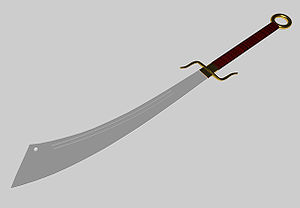Dadao
| Dadao | |
|---|---|

|
|
| Information | |
| Weapon type: | Saber , sword |
| Designations: | Dadao |
| Use: | weapon |
| Region of origin / author: |
China |
| Distribution: | China |
| Overall length: | about 81 cm |
| Handle: | Wood, fabric, leather |
| Lists on the subject | |
The Dadao ( Chinese 大刀 , Pinyin dādāo - "large saber, large saber") comes from Chinese and is often literally translated as "large, broad knife ". In China, this term without context is generally understood to mean a tool or weapon with a single-edged blade . In historical weaponry, it is generally understood to mean both one or two-handed cutting weapons with a mostly wide cutting edge as well as large polearms such as the guandao , similar to the European galleon or halberd . From a technical point of view, however, Dadao belongs to the saber family because it has a curved edge and is of course related to the other Dao weapons.
origin
The Dadao is an ancient weapon of war that, thanks to its shape and weight, is suitable for penetrating enemy armor. Like many weapons, it has its origins in agriculture, but has never been used much in the military sector. In the martial arts, however, it is very well known. The Dadao is very popular to show at competitions. Despite its size, it is very manoeuvrable and also very light. The Imperial Guard used to have to take an exam on this weapon. They had to prove that they were able to punch through a copper rod as thick as a thumb with the weapon.
Description of the weapon
It has a curved, single-edged blade without a central ridge but with two hollow paths (wrongly blood channel ). The Dadao has a long shaft with a ring as a pommel. A leather bracelet was usually attached there so that the weapon did not get lost in the fight. The blade and the tang are made of one piece. The handle (handle) is wrapped with leather or sturdy fabric to ensure a better grip. The weapon was very easy to use. The Dao techniques are generally simpler and more direct than those of the Jian . Due to its shape, the Dadao allows direct and offensive attacks, but is also able to show hard blocks and defense techniques.
See also
literature
- Werner Lind : The dictionary of martial arts. Sportverlag Berlin, ISBN 3-328-00838-1 .
- Arms & Armor V3.5 , Bastion Press, Inc., 2004, ISBN 978-1-59263-016-5 .
- Yang Hong: Weapons in ancient China. Science Press, 1992, ISBN 978-1-880132-03-6 .
